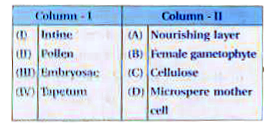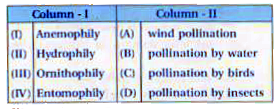Match the following ..............
I) External fertilizaion(i) pollen gainII) Androecium(ii) anther wallIII) Male gametophyte (iii) algaeIv) Primary parietal layer(iv) stamensSolution in Tamil
I−(iv),II−(i),III−(ii),IV−(iii)
I−(iii),II−(iv),III−(i),IV−(ii)
I−(iii),II−(iv),III−(ii),IV−(i)
I−(iii),II−(i),III−(iv),IV−(ii)
The correct Answer is:B
Step by step video, text & image solution for Match the following .............. {:("I) External fertilizaion","(i) pollen gain"),("II) Androecium","(ii) anther wall"),("III) Male gametophyte ","(iii) algae"),("Iv) Primary parietal layer","(iv) stamens"):} by Biology experts to help you in doubts & scoring excellent marks in Class 12 exams.
Updated on:21/07/2023Topper's Solved these Questions
- ASEXUAL AND SEXUAL REPRODUCTION IN PLANTSBOOK - FULL MARKSCHAPTER - ASEXUAL AND SEXUAL REPRODUCTION IN PLANTSEXERCISE - Additional Questions (1- Mark Questios)
60 Videos
- ASEXUAL AND SEXUAL REPRODUCTION IN PLANTSBOOK - FULL MARKSCHAPTER - ASEXUAL AND SEXUAL REPRODUCTION IN PLANTSEXERCISE - Additional Questions (2- Mark Questios)
49 Videos
- APPLICATIONS OF BIOTECHNOLOGY BOOK - FULL MARKSCHAPTER - APPLICATIONS OF BIOTECHNOLOGY EXERCISE - HIGHER ORDER THINKING SKILLS (HOTs) QUESTIONS
7 Videos
- BIODIVERSITY AND ITS CONSERVATION BOOK - FULL MARKSCHAPTER - BIODIVERSITY AND ITS CONSERVATION EXERCISE - Higher Order Thinking Skills (HOT) Questions
5 Videos
Similar Questions
Match the following :
(1) Conidia (i) Yeast(2) Budding (ii) Bacteria (3) Gamma cups(iii) Aspergillus(4) Binary fission(iv) Marchantia
View SolutionWrite the name of organisms that undergo the following of asexual reproduction.
(a) Budding (b) fragmentation (c) Regeneration (d) Gemma cup formation.
View SolutionThe immune system of a person is suppressed,. In ELISA test, the result is positive
(i) Name the disease associated with condition.
(ii) Why did he loose his immunity?
View SolutionWhat will be the result, if the relationship between species richness and area for wide variety of taxa are plotted on a long scale?
View SolutionFind : (i) 932 (ii) 3225 (iii) 1634 (iv) 125−13
View SolutionPredict the order of reactivity of following compounds in dehydrohalogenation. a. I. II. III. IV. V. b. I. II. III. IV.
View Solutionनिम्नलिखित के चित्र बनाइए :
(i) बीजाण्ड , (ii) परागकोष , (iii) परागकण
View SolutionMatch the column-
Column IColumn IIA Toxinsi. MorphineB Alkaloidsii. AbrinC Lectinsiii. VinblastinD. Drugsiv. Concanavalin A
ABCDiiiiiiiviiiiiiiviiiiviiiviiiiii
View SolutionSelect the combination that correctly marches the fungi to respective class. {:(,(1),(2),(3),(4)),((I),i,iii,iv,ii),((II),ii,iii,iv,i),((III),iii,ii,i,iv),((IV),iv,i,ii,iii):}
View SolutionMatch the followings and choose the correct answer. (A) (a - ii), (b - iii), (c - iv), (d - i) (B) (a - iii), (b - ii), (c - iv), (d - i) (C) (a - i), (b - iii), (c - ii), (d - iv) (D) (a - ii), (b - iv), (c - iii), (d - i)
View SolutionMatch the following with reference to cockroach and choose the correct option. (A) (a - iii), (b - iv), (c - ii), (d - i) (B) (a - iv), (b - iii), (c - ii), (d - i) (C) (a - iv), (b - ii), (c - iii), (d - i) (D) (a - ii), (b - iv), (c - iii), (d - i)
View SolutionMatch the followings and choose the correct answer.

(A) (a - iii), (b - i), (c - ii), (d - iv)
(B) (a - ii), (b - i), (c - iv), (d - iii)
(C) (a - iii), (b - iv), (c - ii), (d - i)
(D) (a - iii), (b - i), (c - iv), (d - ii)
View SolutionMatch the two columns:

(A) (I-C), (II-D), (III-B), (IV-A)
(B) (I-D), (II-C), (III-A), (IV-B)
(C) (I-C), (II-B),(III-D), (IV-A)
(D) (I-B),(II-D),(III-C),(IV-A)
View SolutionMatch the two columns:

(A) (I-A), (II-B), (III-C), (IV-D)
(B) (I-B), (II-A), (III-C), (IV-D)
(C) (I-A), (II-C), (III-B), (IV-D)
(D) (I-D), (II-B), (III-C), (IV-A)
View SolutionStudy the following statement and choose the option: (I) Tapetum nourishes the developing pollen grains (II) Hilum represents the junctions between ovule and funicle (III) In aquatic plant such as water hyacinth and water lily, pollination by water (IV) The primary endosperm nucleus is triploid (A) I and II are correct but III and IV are incorrect (B) I, II and IV are correct but III is incorrect (C) II, III and IV are correct but I is incorrect (D) I and IV are correct but II and III are incorrect
View Solution
